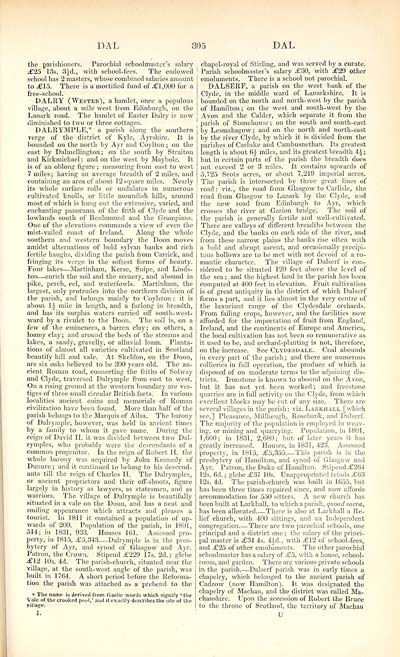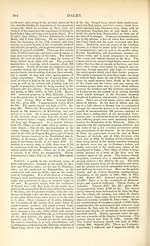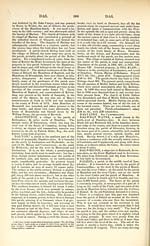Topographical, statistical, and historical gazetteer of Scotland > Volume 1
(387) Page 305
Download files
Complete book:
Individual page:
Thumbnail gallery: Grid view | List view

DAL
30<j
DAL
the parishioners. Parochial schoolmaster's salary
£25 13s. 3£d., with school-fees. The endowed
school has 2 masters, whose combined salaries amount
to £15. There is a mortified fund of £ 1,000 for a
free-school.
DALRY (Wester), a hamlet, once a populous
village, about a mile west from Edinburgh, on the
Lanark road. The hamlet of Easter Dairy is now
diminished to two or three cottages.
DALRYMPLE,* a parish along the southern
verge of the district of Kyle, Ayrshire. It is
bounded on the north by Ayr and Coylton ; on the
east by Dalmellington ; on the south by Straiton
and Kirkmichael ; and on the west by Maybole. It
is of an oblong figure ; measuring from east to west
7 miles; having an average breadth of 2 miles, and
containing an area of about 12 square miles. Nearly
its whole surface rolls or undulates in numerous
cultivated knolls, or little moundish hills, around
most of which is hung out the extensive, varied, and
enchanting panorama of the frith of Clyde and the
lowlands south of Benlomond and the Grampians.
One of the elevations commands a view of even the
mist-vailed coast of Ireland. Along the whole
southern and western boundary the Doon moves
amidst alternations of bold sylvan banks and rich
fertile haughs, dividing the parish from Carrick, and
fringing its verge in the softest forms of beauty.
Four lakes — Martinham, Kerse, Snipe, and Linds-
ton — enrich the soil and the scenery, and abound in
pike, perch, eel, and waterfowls. Martinham, the
largest, only protrudes into the northern division of
the parish, and belongs mainly to Coylston : it is
about li mile in length, and a furlong in breadth,
and has its surplus waters carried off south-west-
ward by a rivulet to the Doon. The soil is, on a
few of the eminences, a barren clay; on others, a
loamy clay ; and around the beds of the streams and
lakes, a sandy, gravelly, or alluvial loam. Planta-
tions of almost all varieties cultivated in Scotland
beautify hill and vale. At Skeldon, on the Doon,
are six oaks believed to be 300 years old. The an-
cient Roman road, connecting the friths of Solway
and Clyde, traversed Dalrymple from east to west.
On a rising ground at the western boundary are ves-
tiges of three small circular British forts. In various
localities ancient coins and memorials of Roman
civilization have been found. More than half of the
parish belongs to the Marquis of Ailsa. The barony
of Dalrymple, however, was held in ancient times
by a family to whom it gave name. During the
reign of David II. it was divided between two Dal-
rymples, who probably were the descendants of a
common progenitor. In the reign of Robert II. the
whole barony was acquired by John Kennedy of
Dunure ; and it continued to belong to his descend-
ants till the reign of Charles II. The Dalrymples,
or ancient proprietors and their off-shoots, figure
largely in history as lawyers, as statesmen, and as
warriors. The village of Dalrymple is beautifully
situated in a vale on the Doon, and has a neat and
smiling appearance which attracts and pleases a
tourist. In 1811 it contained a population of up-
wards of 200. Population of the parish, in 1801,
514; in 1831, 933. Houses 161. Assessed pro-
perty, in 1815, ±"5,343 Dalrymple is in the pres-
bytery of Ayr, and synod of Glasgow and Ayr.
Patron, the Crown. Stipend £229 17s. 2d.; glebe
.£12 10s. 4d. The parish-church, situated near the
village, at the south-west angle of the parish, was
built in 1 764. A short period before the Reforma-
tion the parish was attached as a prebend to the
* Tile name is derived from Gaelic words which signify ' tiie
Vale of the crooked pool,' and it exactly describes the site of the
Tillage.
chapel-royal of Stirling, and was served by a curate.
Parish schoolmaster's salary £30, with £29 other
emoluments. There is a school not parochial.
DALSERF, a parish on the west bank of the
Clyde, in the middle ward of Lanarkshire. It is
bounded on the north and north-west by the parish
of Hamilton; on the west and south-west by the
Avon and the Calder, which separate it from the
parish of Stonehouse ; on the south and south-east
by Lesmahagow ; and on the north and north-east
by the river Clyde, by which it is divided from the
parishes of Carluke and Cambusnethan. Its greatest
length is about 6^ miles, and its greatest breadth 4J ;
but in certain parts of the parish the breadth does
not exceed 2 or 3 miles. It contains upwards of
5,725 Scots acres, or about 7,219 imperial acres.
The parish is intersected by three great lines of
road: viz., the road from Glasgow to Carlisle, the
road from Glasgow to Lanark by the Clyde, and
the new road from Edinburgh to Ayr, which
crosses the river at Garion bridge. The soil of
the parish is generally fertile and well-cultivated.
There are valleys of different breadths between the
Clyde, and the banks on each side of the river, and
from these narrow plains the banks rise often with
a bold and abrupt ascent, and occasionally precipi-
tous hollows are to be met with not devoid of a ro-
mantic character. The village of Dalserf is con-
sidered to be situated 120 feet above the level of
the sea ; and the highest land in the parish has been
computed at 400 feet in elevation. Fruit cultivation
is of great antiquity in the district of which Dalserf
forms a part, and it lies almost in the very centre of
the luxuriant range of the Clydesdale orchards.
From failing crops, however, and the facilities now
afforded for the importation of fruit from England,
Ireland, and the continents of Europe and America,
the local cultivation has not been so remunerative as
it used to be, and orchard-planting is not, therefore,
on the increase. See Clydesdale. Coal abounds
in every part of the parish ; and there are numerous
collieries in full operation, the produce of which is
disposed of on moderate terms to the adjoining dis-
tricts. Ironstone is known to abound on the Avon,
but it has not yet been worked ; and freestone
quarries are in full activity on the Clyde, from which
excellent blocks may be cut of any size. There are
several villages in the parish : viz. Larkhall [which
see,] Pleasance, Millheugh, Rosebank, and Dalserf.
The majority of the population is employed in weav-
ing, or mining and quarrying. Population, in 1801,
1,660; in 1831, 2,680; but of later years it has
greatly increased. Houses, in 1831, 423. Assessed
property, in 1815, £5,355 This parish is in the
presbytery of Hamilton, and synod of Glasgow and
Ayr. Patron, the Duke of Hamilton. Stipend £264
12s. 6d. ; glebe £37 10s. Unappropriated teinds £63
12s. 4d. The parish-church was built in 1655, but
has been three times repaired since, and now affords
accommodation for 550 sitters. A new church has
been built at Larkhall, to which a parish, quoad sacra,
has been allocated There is also at Larkhall a Re-
lief church, with 400 sittings, and an Independent
congregation There are two parochial schools, one
principal and a district one ; the salary of the princi-
pal master is £34 4s. 44d., with £12 of school-fees,
and £25 of other emoluments. The other parochial
schoolmaster has a salary of £5, with a house, school-
room, and garden. There are various private schools
in the parish Dalserf parish was in early times a
chapelry, which belonged to the ancient parish of
Cadzow (now Hamilton). It was designated the
chapelry of Machan, and the district was called Ma-
ehanshire. Upon the accession of Robert the Bruce
to the throne of Scotland, the territory of Machan
U
30<j
DAL
the parishioners. Parochial schoolmaster's salary
£25 13s. 3£d., with school-fees. The endowed
school has 2 masters, whose combined salaries amount
to £15. There is a mortified fund of £ 1,000 for a
free-school.
DALRY (Wester), a hamlet, once a populous
village, about a mile west from Edinburgh, on the
Lanark road. The hamlet of Easter Dairy is now
diminished to two or three cottages.
DALRYMPLE,* a parish along the southern
verge of the district of Kyle, Ayrshire. It is
bounded on the north by Ayr and Coylton ; on the
east by Dalmellington ; on the south by Straiton
and Kirkmichael ; and on the west by Maybole. It
is of an oblong figure ; measuring from east to west
7 miles; having an average breadth of 2 miles, and
containing an area of about 12 square miles. Nearly
its whole surface rolls or undulates in numerous
cultivated knolls, or little moundish hills, around
most of which is hung out the extensive, varied, and
enchanting panorama of the frith of Clyde and the
lowlands south of Benlomond and the Grampians.
One of the elevations commands a view of even the
mist-vailed coast of Ireland. Along the whole
southern and western boundary the Doon moves
amidst alternations of bold sylvan banks and rich
fertile haughs, dividing the parish from Carrick, and
fringing its verge in the softest forms of beauty.
Four lakes — Martinham, Kerse, Snipe, and Linds-
ton — enrich the soil and the scenery, and abound in
pike, perch, eel, and waterfowls. Martinham, the
largest, only protrudes into the northern division of
the parish, and belongs mainly to Coylston : it is
about li mile in length, and a furlong in breadth,
and has its surplus waters carried off south-west-
ward by a rivulet to the Doon. The soil is, on a
few of the eminences, a barren clay; on others, a
loamy clay ; and around the beds of the streams and
lakes, a sandy, gravelly, or alluvial loam. Planta-
tions of almost all varieties cultivated in Scotland
beautify hill and vale. At Skeldon, on the Doon,
are six oaks believed to be 300 years old. The an-
cient Roman road, connecting the friths of Solway
and Clyde, traversed Dalrymple from east to west.
On a rising ground at the western boundary are ves-
tiges of three small circular British forts. In various
localities ancient coins and memorials of Roman
civilization have been found. More than half of the
parish belongs to the Marquis of Ailsa. The barony
of Dalrymple, however, was held in ancient times
by a family to whom it gave name. During the
reign of David II. it was divided between two Dal-
rymples, who probably were the descendants of a
common progenitor. In the reign of Robert II. the
whole barony was acquired by John Kennedy of
Dunure ; and it continued to belong to his descend-
ants till the reign of Charles II. The Dalrymples,
or ancient proprietors and their off-shoots, figure
largely in history as lawyers, as statesmen, and as
warriors. The village of Dalrymple is beautifully
situated in a vale on the Doon, and has a neat and
smiling appearance which attracts and pleases a
tourist. In 1811 it contained a population of up-
wards of 200. Population of the parish, in 1801,
514; in 1831, 933. Houses 161. Assessed pro-
perty, in 1815, ±"5,343 Dalrymple is in the pres-
bytery of Ayr, and synod of Glasgow and Ayr.
Patron, the Crown. Stipend £229 17s. 2d.; glebe
.£12 10s. 4d. The parish-church, situated near the
village, at the south-west angle of the parish, was
built in 1 764. A short period before the Reforma-
tion the parish was attached as a prebend to the
* Tile name is derived from Gaelic words which signify ' tiie
Vale of the crooked pool,' and it exactly describes the site of the
Tillage.
chapel-royal of Stirling, and was served by a curate.
Parish schoolmaster's salary £30, with £29 other
emoluments. There is a school not parochial.
DALSERF, a parish on the west bank of the
Clyde, in the middle ward of Lanarkshire. It is
bounded on the north and north-west by the parish
of Hamilton; on the west and south-west by the
Avon and the Calder, which separate it from the
parish of Stonehouse ; on the south and south-east
by Lesmahagow ; and on the north and north-east
by the river Clyde, by which it is divided from the
parishes of Carluke and Cambusnethan. Its greatest
length is about 6^ miles, and its greatest breadth 4J ;
but in certain parts of the parish the breadth does
not exceed 2 or 3 miles. It contains upwards of
5,725 Scots acres, or about 7,219 imperial acres.
The parish is intersected by three great lines of
road: viz., the road from Glasgow to Carlisle, the
road from Glasgow to Lanark by the Clyde, and
the new road from Edinburgh to Ayr, which
crosses the river at Garion bridge. The soil of
the parish is generally fertile and well-cultivated.
There are valleys of different breadths between the
Clyde, and the banks on each side of the river, and
from these narrow plains the banks rise often with
a bold and abrupt ascent, and occasionally precipi-
tous hollows are to be met with not devoid of a ro-
mantic character. The village of Dalserf is con-
sidered to be situated 120 feet above the level of
the sea ; and the highest land in the parish has been
computed at 400 feet in elevation. Fruit cultivation
is of great antiquity in the district of which Dalserf
forms a part, and it lies almost in the very centre of
the luxuriant range of the Clydesdale orchards.
From failing crops, however, and the facilities now
afforded for the importation of fruit from England,
Ireland, and the continents of Europe and America,
the local cultivation has not been so remunerative as
it used to be, and orchard-planting is not, therefore,
on the increase. See Clydesdale. Coal abounds
in every part of the parish ; and there are numerous
collieries in full operation, the produce of which is
disposed of on moderate terms to the adjoining dis-
tricts. Ironstone is known to abound on the Avon,
but it has not yet been worked ; and freestone
quarries are in full activity on the Clyde, from which
excellent blocks may be cut of any size. There are
several villages in the parish : viz. Larkhall [which
see,] Pleasance, Millheugh, Rosebank, and Dalserf.
The majority of the population is employed in weav-
ing, or mining and quarrying. Population, in 1801,
1,660; in 1831, 2,680; but of later years it has
greatly increased. Houses, in 1831, 423. Assessed
property, in 1815, £5,355 This parish is in the
presbytery of Hamilton, and synod of Glasgow and
Ayr. Patron, the Duke of Hamilton. Stipend £264
12s. 6d. ; glebe £37 10s. Unappropriated teinds £63
12s. 4d. The parish-church was built in 1655, but
has been three times repaired since, and now affords
accommodation for 550 sitters. A new church has
been built at Larkhall, to which a parish, quoad sacra,
has been allocated There is also at Larkhall a Re-
lief church, with 400 sittings, and an Independent
congregation There are two parochial schools, one
principal and a district one ; the salary of the princi-
pal master is £34 4s. 44d., with £12 of school-fees,
and £25 of other emoluments. The other parochial
schoolmaster has a salary of £5, with a house, school-
room, and garden. There are various private schools
in the parish Dalserf parish was in early times a
chapelry, which belonged to the ancient parish of
Cadzow (now Hamilton). It was designated the
chapelry of Machan, and the district was called Ma-
ehanshire. Upon the accession of Robert the Bruce
to the throne of Scotland, the territory of Machan
U
Set display mode to: Large image | Transcription
Images and transcriptions on this page, including medium image downloads, may be used under the Creative Commons Attribution 4.0 International Licence unless otherwise stated. ![]()
| Gazetteers of Scotland, 1803-1901 > Topographical, statistical, and historical gazetteer of Scotland > Volume 1 > (387) Page 305 |
|---|
| Permanent URL | https://digital.nls.uk/97442190 |
|---|
| Description | Volume first. A-H. |
|---|---|
| Attribution and copyright: |
|

